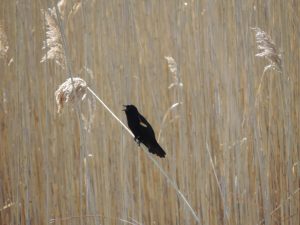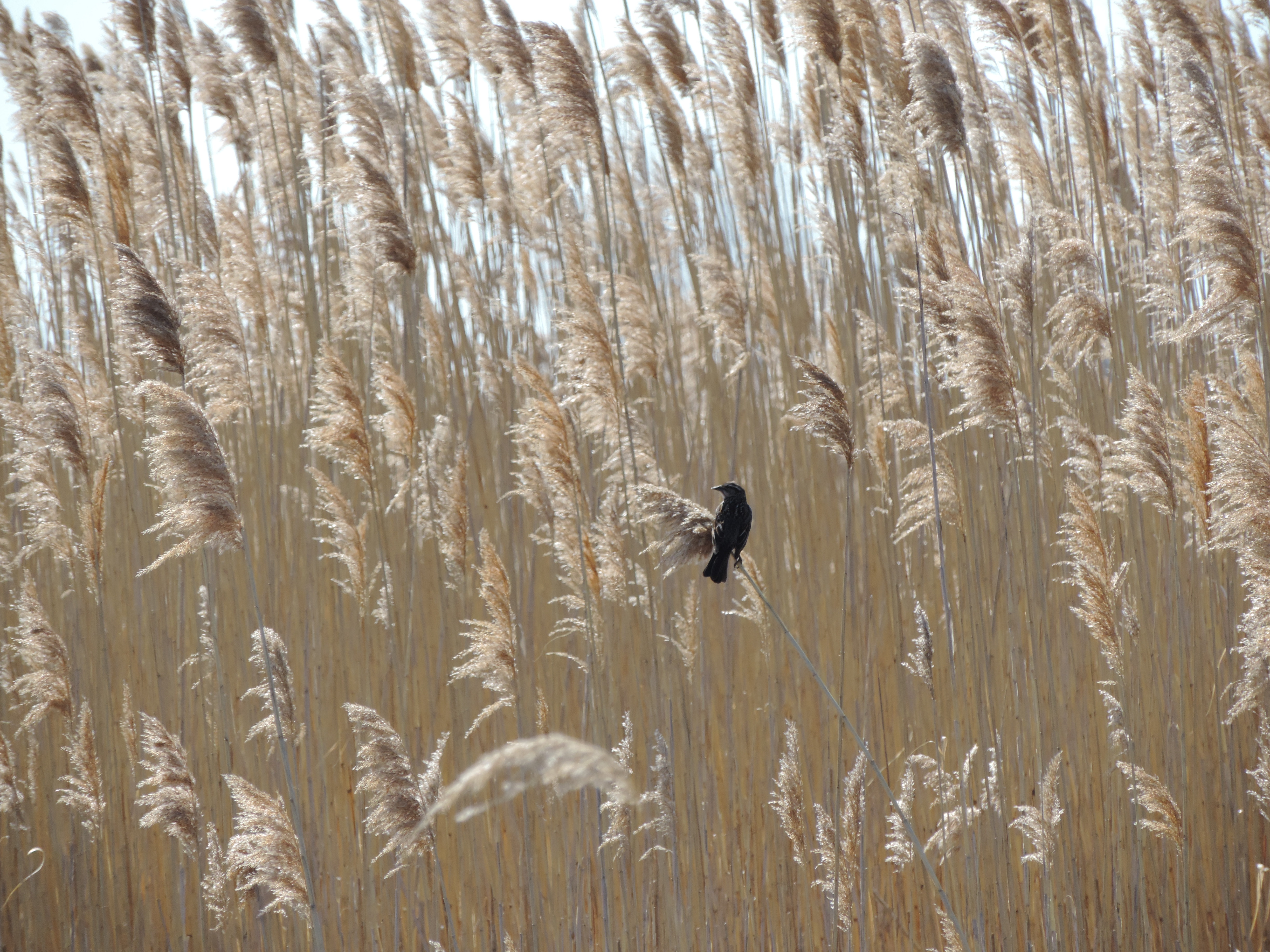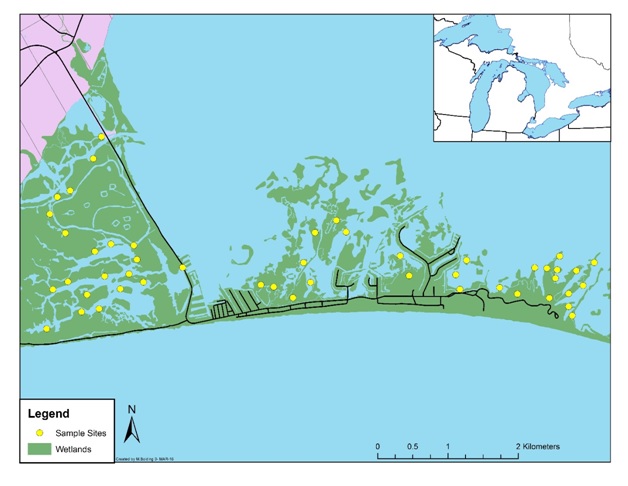June 13, 2016
Courtney Robichaud and Dr. Rebecca Rooney (University of Waterloo, Ontario)

A Redwinged Blackbird in invasive Phragmites
Summary
A 2002 study found that the number and diversity of birds was higher in wetlands invaded by Phragmites. We repeated this study 12 years later at the same location where the extent of Phragmites invasion has worsened dramatically. We also looked at how the types of birds using the marsh might be changing. We found the same number of species using Phragmites as using marsh meadow or cattail habitats, but found that there were fewer individual birds overall. We also found that birds specialising in marsh meadow or cattail habitats were being excluded in favour of more generalist species – this is a bad sign for specialist species like the threatened Least Bittern.
Background: Long Point Coastal Marshes
Non-native Phragmites australis has been present in Long Point, Ontario since the late 1990s. The coastal marshes of Long Point are part of a designated world Biosphere Reserve and globally significant Important Bird Area. These wetlands provide critical habitat for birds who require marshes for breeding and nesting habitat, such as the threatened Least Bittern – who are in decline throughout the southern Great Lakes basin. The vital role these marshes have is threatened by non-native Phragmites australis.
Previous Study
In 2002, a study investigated the effects of Phragmites invasion on bird abundance and species richness. Surprisingly, this research found that the number of individual birds and the number of bird species was actually higher in Phragmites, especially at the edge of the Phragmites patches. Although they did find fewer marsh-dependent birds nesting in Phragmites, their work concluded that Phragmites stands provided suitable habitat for many birds.
Our Study
Twelve years later, we repeated this study to see if a decade of unchecked invasion has changed what effect Phragmites has on birds. Like the earlier study, our goal was to understand the effect invasion has on the total number of birds and the number of bird species using the marsh. Unlike the prior study, however, we also looked into how the identity of species in the marsh might be changing and what the implications are in terms of bird community functional traits such as diet, foraging strategy, and nesting preferences.
Our Results
Things have changed since the first study was carried out. We found that Phragmites habitats had fewer individual birds compared to marsh meadow or cattail, but the same number of species. Unlike the study from 2002, we found no increase in the number of individuals or species using the edges of Phragmites stands. We suspect that these differences are due to the advancement of Phragmites in the wetland. Early on, when stands were small and relatively thin, patches of Phragmites might have boosted habitat structural diversity and attracted more species of birds in greater numbers. Over a decade later, Phragmites stands have filled in the wetland, so the region has less structural diversity than it did back in 2002.
The alarming results emerge when we consider the types of birds using Phragmites compared to the marsh meadow and cattail zones – Phragmites appears to blur the lines between habitats. This is likely because Phragmites acts as a bridge between the wet cattail community and drier marsh meadow. Fewer birds that depend on marsh meadow or cattail to survive were spotted in the Phragmites, and appear to be excluded from the site. Generalist species that used to be divided between cattail and marsh meadow now mix in Phragmites. The consequences of this mixing are not fully understood yet, but it has implications for biodiversity in the marsh as a whole. As Phragmites replaces more and more of the historical cattail and marsh meadow habitat, we won’t see a drop in the number of species at any point in space, but they will all be the subset of birds that use Phragmites: e.g., Common Yellowthroat and Red-winged Blackbirds. The herons, bitterns, terns and swallows that do not use Phragmites will be lost.
Next Steps
Our work highlights the need to consider the identity of species using the marsh, rather than just tallying up the total number of species present. Phragmites invasion can exclude sensitive species, such as marsh nesters, and replace them with more generalist species, causing a shift in bird community and their functional traits. We are also seeing that the effects of Phragmites invasion can have a lag time, as the increase in bird numbers observed during the early stages of invasion is now replaced by a reduction in abundance and shift in bird community composition.
A manuscript describing this study in detail is currently in development. Check out this page to learn more about Dr. Rooney’s lab at the University of Waterloo.

Further Reading
1. COSEWIC. (2003) Canadian Species at Risk, May 2003. Ottawa: Committee on the Status of Endangered Wildlife in Canada
2. Ball, H., J. Jalava, T. King, L. Maynard, B. Potter, and T. Pulfer. (2003) The Ontario Great Lakes coastal wetland atlas: A summary of information (1983-1997). Canadian Wildlife Service: Toronto, Ontario. 57
3. Tozer, D.C. (2016) Marsh bird occupancy dynamics, trends, and conservation in the southern Great Lakes basin: 1996 to 2013 Journal of Great Lakes Research 42: 136-145
4. Wilcox, K.L., S.A. Petrie, L.A. Maynard, and S.W. Meyer. (2003) Historical distribution and abundance of Phragmites australis at Long Point, Lake Erie, Ontario. Journal of Great Lakes Research 29:664-680
5. Windham, L., and Lathrop, R.G. (1999) Effects of Phragmites australis (Common Reed) Invasion on Aboveground Biomass and Soil Properties in Brackish Tidal Marsh of the Mullica River, New Jersey Estuaries 22(4): 927-935
6. Meyer, S. W., Badzinkski, S.S., Petrie, S.A., and Ankney, D.C. (2010) Seasonal Abundance and Species Richness of Birds in Common Reed Habitats in Lake Erie Journal of Wildlife Management 74(7): 1559-1567

